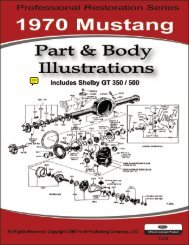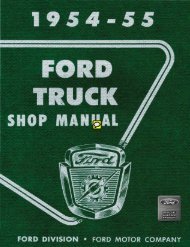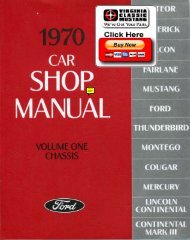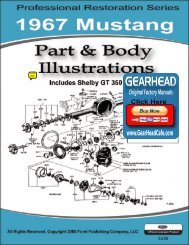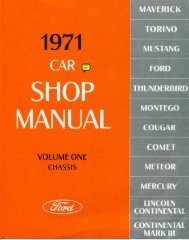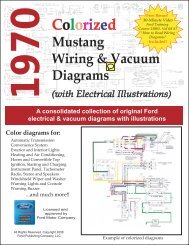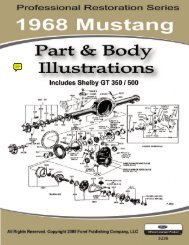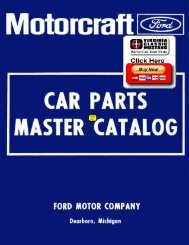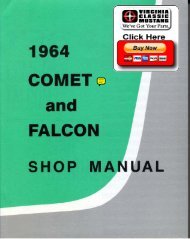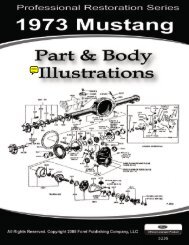DEMO - 1965 Ford Truck Shop Manual - ForelPublishing.com
DEMO - 1965 Ford Truck Shop Manual - ForelPublishing.com
DEMO - 1965 Ford Truck Shop Manual - ForelPublishing.com
Create successful ePaper yourself
Turn your PDF publications into a flip-book with our unique Google optimized e-Paper software.
PART 2-7-AIR BRAKES 2-77<br />
on brackets at either side of the<br />
rear of the cab.<br />
OPERATING PRINCIPLES<br />
The trailer system has its own<br />
reservoir and has a brake chamber<br />
and slack adjuster for each wheel the<br />
same as the tractor system. Both systems<br />
are supplied by the one air<br />
<strong>com</strong>pressor and are controlled by<br />
the foot control brake valve. The two<br />
systems are connected by two hoses<br />
running between the tractor protection<br />
valve mounted on the cab and<br />
the relay emergency valve on the<br />
trailer.<br />
The foot controlled brake valve<br />
operates both tractor and trailer<br />
brakes simultaneously. The hand<br />
controlled brake valve operates the<br />
trailer brakes only. Although they<br />
operate independently of each other,<br />
both hand and foot controlled brake<br />
valves apply pressure through the<br />
same service line going to the trailer.<br />
Both valves operate the trailer brakes<br />
in exactly the same manner.<br />
Normal Operation. When its control<br />
lever is in the NORMAL position,<br />
the manual emergency valve<br />
directs tractor reservoir pressure to<br />
the top side of the diaphragm in the<br />
tractor protection valve. The reservoir<br />
pressure depresses the diaphragm<br />
and forces the valve plungers down<br />
holding open the two valves (serviceexhaust<br />
and disc) in the tractor protection<br />
valve assembly. With the disc<br />
valve open, tractor reservoir pressure<br />
can flow through the emergency<br />
line to the relay emergency valve on<br />
the trailer.<br />
As tractor reservoir pressure flows<br />
into the relay emergency valve, it<br />
forces the emergency diaphragm up,<br />
holding the emergency valve open<br />
and the port closed.<br />
CHARGING THE TRAILER<br />
RESERVOIR. Since the emergency<br />
port is held closed by the diaphragm<br />
and the supply valve is held closed<br />
by spring pressure, no reservoir<br />
pressure can go to the trailer brake<br />
chambers. Tractor reservoir pressure,<br />
however, does open the check<br />
valve allowing air to flow from the<br />
tractor reservoir to the trailer reservoir.<br />
As soon as the pressure in the<br />
two reservoirs be<strong>com</strong>es equalized,<br />
the check valve will close.<br />
APPLIED POSITION. Operation<br />
of either the hand or the foot control<br />
brake valve directs tractor reservoir<br />
pressure through the service line<br />
and through the open service valve<br />
(within the tractor protection valve<br />
assembly) to the relay emergency<br />
valve on the trailer.<br />
As the pressure enters the top of<br />
the relay emergency valve, it forces<br />
the relay diaphragm down against<br />
spring pressure to open the supply<br />
valve. Also the emergency valve is<br />
still being held open by pressure<br />
from the emergency line applied<br />
against the emergency diaphragm.<br />
Therefore, pressure flows from the<br />
trailer reservoir through the open<br />
supply and emergency valves to the<br />
trailer brake chambers.<br />
BALANCED POSITION. If the<br />
brake valve is actuated and then<br />
held at a partially applied position,<br />
the bleeder passage will allow the<br />
pressure on each side of the relay<br />
diaphragm to equalize and, thus, return<br />
the diaphragm to its normal<br />
position. With the diaphragm neither<br />
depressed nor raised, both the supply<br />
valve and the exhaust port are<br />
closed. Pressure can neither enter<br />
nor leave the brake chambers. The<br />
brakes hold.<br />
RELEASED POSITION. When<br />
the brake valve is released, it exhausts<br />
the pressure from the upper<br />
side of the relay diaphragm. As a<br />
result, the higher pressure from the<br />
brake chambers raises the outer ends<br />
of the diaphragm to open the exhaust<br />
port. With the exhaust port<br />
open, air exhausts from the brake<br />
chambers releasing the trailer brakes.<br />
Emergency Operation. The manual<br />
emergency valve is moved from<br />
the NORMAL to the EMERGENCY<br />
position in either of two cases: if<br />
the trailer breaks away from the<br />
tractor; or when emergency application<br />
is desired at the trailer brakes<br />
because of tractor brake failure. In<br />
either case, moving the manual valve<br />
to the EMERGENCY position exhausts<br />
air pressure from the upper<br />
side of the diaphragm in the tractor<br />
protection valve. As the diaphragm<br />
is released, spring pressure raises the<br />
valve plungers and closes the two<br />
valves in the tractor protection valve<br />
assembly. The closed service and exhaust<br />
valve shuts off the service line;<br />
the closed disc valve shuts off the<br />
emergency line; therefore, tractor<br />
reservoir pressure is prevented from<br />
passing through the two trailer lines.<br />
TRACTOR BREAK-AWAY. If<br />
the tractor breaks away, the pressure<br />
underneath the emergency diaphragm<br />
in the relay emergency valve exhausts<br />
through the broken emergency<br />
line to atmosphere. This escape<br />
of air allows the diaphragm to<br />
drop back to its released position<br />
which closes the emergency valve<br />
and opens the emergency port. With<br />
the supply, emergency, and check<br />
valves all closed, the trailer reservoir<br />
can not exhaust to atmosphere.<br />
The opening of the emergency port<br />
automatically connects trailer reservoir<br />
pressure to the trailer brake<br />
chambers.<br />
EMERGENCY APPLICATION<br />
-TRAILER ATTACHED. If the<br />
two-way manual valve is moved to<br />
the EMERGENCY position when<br />
the trailer is still attached, the pressure<br />
from underneath the emergency<br />
diaphragm (in the relay emergency<br />
valve) exhausts through the tractor<br />
protection valve instead of the broken<br />
emergency hose. The alternate route<br />
of the exhaust air is through the unbroken<br />
hose. Since the tractor protection<br />
valve is in the emergency<br />
position, the valve plungers are no<br />
longer seated against the valves;<br />
therefore, air from the trailer lines<br />
exhausts through the drilled passages<br />
in the valve plungers and out the exhaust<br />
port.<br />
Front Wheel Limiting Valve. The<br />
limiting valve instantly limits air<br />
pressure delivery at the front wheel<br />
brake chambers according to road<br />
and load conditions and while the<br />
truck is in motion. This limited pressure<br />
at the front brakes permits the<br />
rear brakes to function with greater<br />
force than the front brakes.<br />
The limiting valve is mounted on<br />
the dash. An air line from the delivery<br />
port of the brake control valve<br />
connects to the inlet port of the limiting<br />
valve. Another air line connects<br />
the delivery port of the limiting valve<br />
to the front quick release valve.<br />
The delivery pressure from the<br />
limiting valve is controlled by a<br />
spring-loaded piston, which closes<br />
the inlet valve when the pressure<br />
setting of the spring is reached. The<br />
pressure setting of the spring is controlled<br />
by a hand knob, which may<br />
be set for four different pressures<br />
indicated on the dial: (1) at FULL,<br />
approximately full reservoir pressure<br />
delivered to the front brakes;<br />
(2) the next setting delivers 55 lbs.<br />
pressure; (3) the next 44 lbs., and<br />
LOW delivers 20 lbs. Under normal<br />
conditions, the limiting valve should<br />
always be set at the FULL position.<br />
Lower settings should be used only<br />
when required by unusual road and<br />
load conditions.




